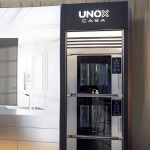Innovative biomaterials shape the identity of Le Magasin Électrique
Le Magasin Électrique, the extraordinary workspace envisioned by circular-design lab Atelier Luma in collaboration with studios Assemble and BC Architects & Studies, stands as a testament to the power of biomaterials in the world of architecture and design.
Rooted in a bioregional approach, the project redefines sustainability by showcasing a captivating fusion of design and natural elements.

GALLERY
Atelier Luma’s core philosophy revolves around embracing the essence of the local environment to produce remarkable structures. This is epitomized in Le Magasin Électrique, where an unconventional palette of biomaterials derived from nearby bio-waste and overlooked materials has been employed. Sunflowers, salt, and algae, among others, play starring roles in shaping the workspace’s distinctive aesthetics and functionality.
Sunflowers, known for their remarkable ability to extract heavy metals from contaminated soil, find a surprising application here. The seeds of these vibrant plants yield oils used in finishes and coatings, offering an eco-friendly alternative to traditional varnishes. This ingenious repurposing not only reduces waste but also infuses the interior spaces with an inviting warmth and character.
The integration of salt within the design may raise eyebrows, yet it speaks volumes about the commitment to sustainability. Salt is harnessed as a binder to create robust materials, challenging conventional construction norms. Its abundance as a by-product and its capacity to lessen the environmental footprint make it an ideal candidate for the bioregional approach. The resultant textures and hues evoke a sense of harmony with the environment, forging a deep connection between the building and its surroundings.
Algae, often perceived as a mere aquatic organism, unveils its versatility in this project. Its ability to absorb carbon dioxide from the atmosphere while proliferating rapidly positions it as an invaluable asset for sustainable construction. Algae-based materials provide a unique amalgamation of aesthetics and functionality, casting an ethereal ambiance throughout the workspace.
The ethos behind Le Magasin Électrique goes beyond its striking visual allure. Atelier Luma’s bioregional approach encapsulates the essence of transformation — turning local resources into innovative, low-carbon building materials. The collaboration between Atelier Luma, Assemble, and BC Architects & Studies redefines design by pushing boundaries, embracing biomaterials as a testament to the potential of circular architecture.
In a world where sustainable design is imperative, Le Magasin Électrique stands as an emblem of inspiration. The integration of sunflowers, salt, and algae into its design narrative underscores the beauty of reimagining the ordinary, breathing life into materials that were once dismissed. This project not only offers a visual feast but also catalyses a shift towards a more conscious and responsible approach to architecture and design.
Images by Adrian Deweerdt via Dezeen
Unox Casa is the high-end residential division of UNOX, the world’s top-selling brand of professional ovens, born to ...
The completion of Parkline Place marks a major milestone for Sydney’s skyline, with the 39-storey commercial tower now ...








